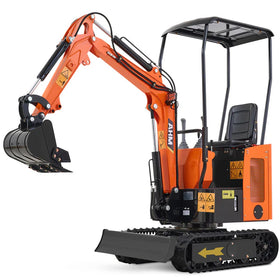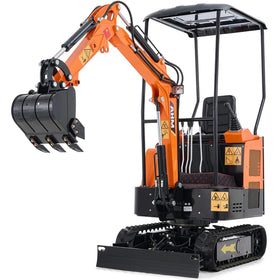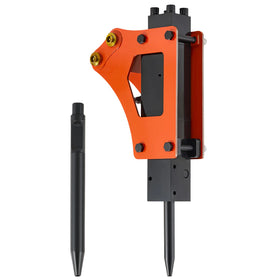Pushing a 75-pound mower uphill through thick August grass for 45 minutes will leave you questioning your life choices! Your back aches, sweat drips everywhere, and you're only halfway through a half-acre lawn.
Meanwhile, your neighbor glides behind their self-propelled mower like they're taking a casual stroll, finishing in 30 minutes without breaking a sweat. What is a self-propelled lawn mower that makes this possible?
It's a walk-behind mower with a built-in drive system that powers the wheels forward, cutting the effort you’ll have to put in by roughly 70% compared to standard push mowers.
The mower moves itself - you just sit back and relax. With self-propelled models now available in all shapes and sizes, the question isn't whether they work, but which type matches your lawn size and terrain.

What Does "Self-Propelled Lawn Mower" Mean?
A self-propelled lawn mower uses its own power source to drive the wheels forward instead of relying on you to push the entire weight across your lawn. The engine or motor splits its power between spinning the cutting blade and rotating the wheels through a transmission system.
When you engage the drive control - usually a lever or bar on the handlebar - power transfers from the engine through a belt to a transmission.
The transmission connects to an axle that turns the wheels, pulling the mower forward automatically. Single-speed models move at one fixed pace (2-3 mph), while variable-speed systems adjust from 1.5 mph for precision work to 3.5+ mph for open areas.
Three Drive System Types
- Front-Wheel Drive (FWD): Front wheels power the mower forward. Lifting the front wheels slightly disengages the drive, making FWD extremely maneuverable around obstacles. Best for flat lawns with trees and flower beds.
- Rear-Wheel Drive (RWD): Power goes to the rear wheels. When you push down on the handle to turn or climb hills, the front wheels lift while the rear wheels maintain traction. Industry data shows RWD provides 40% better uphill performance than FWD models.
- All-Wheel Drive (AWD): All four wheels receive power, delivering maximum traction on steep slopes, wet grass, and loose soil. AWD models cost 30-50% more than FWD or RWD equivalents.

Types of Self-Propelled Lawn Mowers: Gas vs Electric vs Hybrid
1. Gas-Powered Self-Propelled Mowers
Gas mowers use 140cc-190cc engines producing 4-7 horsepower, dominating the market for yards over half an acre. On the negative side, operating a gas mower for one hour produces emissions equivalent to driving a car 300 miles, accounting for roughly 5% of total US air pollution according to EPA estimates.
Key specs:
- Runtime: 45-90 minutes per 0.5-0.8 gallon tank
- Weight: 60-90 pounds
- Power: Handles thick, wet, overgrown grass
- Noise: 85-95 decibels
- Maintenance: Oil changes, spark plugs, air filters, winterization
2. Electric Self-Propelled Mowers
Battery-powered mowers use 40V-80V lithium-ion batteries powering brushless motors delivering 2-4 horsepower equivalent. Average electric self-propelled mowers run 45-50 minutes per charge, easily handling quarter-acre lawns even on sloped terrain.
Key specs:
- Runtime: 30-60 minutes per charge
- Weight: 50-80 pounds (10-20 lbs lighter than gas)
- Charging: 45-90 minutes
- Noise: 65-75 decibels (significantly quieter)
- Maintenance: Blade sharpening and deck cleaning only
- Battery replacement: $100-300 every 3-5 years
3. Hybrid Self-Propelled Mowers
Hybrid mowers combine gasoline engines with electric motor assistance. The gas engine provides cutting power while electric motors handle wheel propulsion, reducing emissions and improving fuel efficiency by 30-40%.
Key specs:
- Runtime: Extended through combined power systems
- Weight: 130-350 pounds, depending on size
- Coverage: 5-7.5 acres per tank on commercial models
- Fuel efficiency: 30-40% better than gas-only models

Self-Propelled vs Push Lawn Mowers: Which Should You Choose?
Here’s your information organized into a clean table:
| Lawn Mower Type | Best For |
|---|---|
| Push Mowers |
Lawns under ¼ acre (10,000 sq ft) Flat, obstacle-free yards Minimal slopes |
| Self-Propelled Mowers |
Quarter-acre to one-acre properties, Slopes and hills, uneven terrain Large yards where fatigue becomes an issue |
1. Physical Effort and Weight
Self-propelled mowers reduce pushing force by approximately 70%. However, they weigh 60-100 pounds compared to 40-60 pounds for push mowers due to the added drive mechanism. When the drive is engaged, this extra weight doesn't matter - the mower moves itself. But when disengaged (for storage or tight turns), you're moving a heavier machine.
2. Price and Cost Comparison
Initial purchase price:
- Basic push mowers: $150-300
- Electric self-propelled: $300-800
- Gas self-propelled: $350-600
- Premium AWD models: $800-1,200
Annual operating costs:
- Electric: $20-40 electricity + battery replacement ($100-300 every 3-5 years)
- Gas: $50-80 fuel + $30-50 maintenance
4. Maintenance Requirements
- Push mowers need minimal maintenance - mainly blade sharpening and deck cleaning.
- Gas self-propelled mowers require oil changes, spark plug replacement, air filter cleaning, and carburetor maintenance.
- Electric self-propelled mowers eliminate engine maintenance entirely, requiring only blade and drive belt care. Proper maintenance means a quality self-propelled lawn mower can easily last 8-10 years.

What Is the Best Self-Propelled Lawn Mower?
The best self-propelled lawn mowers are the ones that match your lawn size, terrain, and power preference. AHM's hybrid lineup delivers performance across different applications.
1. AHM LM-55 Remote Control Hybrid Mower - $3,399.99
The LM-55 combines a 5 hp 4-stroke engine with 12V battery power. The 21.7-inch cutting width handles up to 0.25 acres while the remote control operates from 109-545 yards away. This mower works best for homeowners with steep slopes or mobility limitations needing remote operation. The track-driven system provides superior traction on hills compared to wheeled mowers.
Specifications:
- Power: 5 hp gas + 12V battery hybrid
- Cutting width: 21.7 inches
- Height: 0.4-5 inches adjustable via remote
- Slope: 45-degree climbing capability
- Speed: 0-3.6 mph variable
- Fuel consumption: 0.2 gal/h
- Weight: 286.6 pounds
AHM X80 Remote Control Hybrid Mower - $3,799.99
The X80 brings a 13.6 hp engine and dual 650W electric motors producing 1,034 lbf combined power. Best for large residential properties and light commercial applications, this hybrid system delivers 170% more power than comparable models while reducing fuel consumption.
Specifications:
- Hybrid power: 13.6 hp (459cc) + dual 650W motors
- Cutting width: 31.5 inches
- Blades: 16 sets (32 total)
- Height: 0.8-7.9 inches adjustable
- Remote range: 3,280 feet
- Runtime: 5 hours per tank
- Coverage: 5 acres max, 1 acre/hour
- Weight: 745.2 pounds

The Bottom Line
Now you know the answer to ‘What is a self-propelled lawn mower?’ These mowers excel on lawns from quarter acre to one acre, particularly on slopes and uneven terrain.
Gas-powered models offer unlimited runtime for large properties, electric versions provide quiet, emission-free operation with minimal maintenance, and hybrid mowers like the AHM lineup combine gas power with electric drive efficiency for extended coverage.
Choose a self-propelled mower for lawns over a quarter acre, slopes steeper than 10 degrees, or any situation where sustained mowing has caused you fatigue.







